Deadheading is the process of removing spent flowers to encourage fresh new blooms. Roses are iconic flowers that thrive when they’re deadheaded. Regular deadheading is an important care component of any rose garden, or just a single patio rose. Let’s discover how to deadhead roses and the best methods that keep your roses fresh and attractive all summer long.
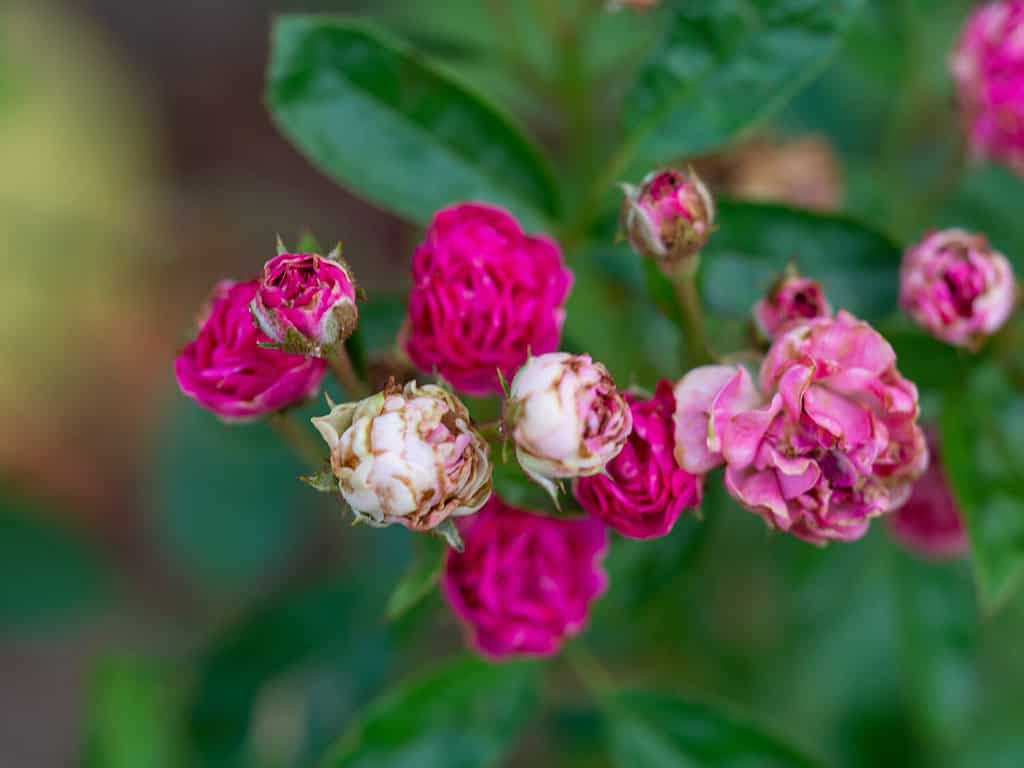
Iconic roses require regular deadheading to look their best.
©Wachiraphorn Thongya/Shutterstock.com
How to Deadhead Roses: Tools Required
Very little is required to deadhead roses. Here’s what you’ll need:
A Pair of Secateurs or Deadheading Snips
It’s no surprise that you’ll need something to cut with. Secateurs work well, but if you’ve lots of roses to deadhead, a pair of deadheading snips that catch tumbling deadheads save picking them afterward.
Thorn-proof gloves
One of the most appealing aspects of deadheading is getting close to beautiful flowers. Immersing yourself in the scent and colors of blooming fabulous roses is a treat, but thorns just love to ruin the fun. To avoid getting stabbed by rose thorns, a pair of thick, thorn-proof gloves is highly recommended.
Some folks like to use rose pruning gloves with long sleeves. These are good for people who need to protect their skin or gardeners tackling vigorous, long-stemmed rambling roses.
A Bucket or Bag
Dead rose blooms rot on the soil and attract pests, plus it doesn’t look good. Use a bucket or bag to collect dead heads and throw them on your compost pile or in the trash.

A clean, sharp pair of secateurs or snips are best for pruning roses.
©photowind/Shutterstock.com
Why Deadheading Roses Is Important
Deadheading roses makes them look great, but there are other benefits, too.
Deadheaded roses keep on performing. They throw out new blooms so long as they have plenty of fertilizer and water. Fresh new blooms appear after a deadheading session because roses dedicate their energy to seed production.
Although we call it deadheading, those spent flowers aren’t actually dead. They are seed production factories. Your rose will devote its energy to reproduction above all else. When its seeds, called rose hips, are cut away via the deadheading process, the rose will immediately try again. This means fresh new flowers for pollination.
It’s a gardener’s trick that’s been employed for thousands of years, ever since humans started cultivating plants for pleasure rather than food.
Another good reason to deadhead roses is rot prevention. We know that deadheads on the ground cause rot, but they also cause rot in situ on the stem. Wet, soggy, dead petals cling to buds and foliage, preventing the bloom and creating a slimy mess. Regular deadheading circumvents it.
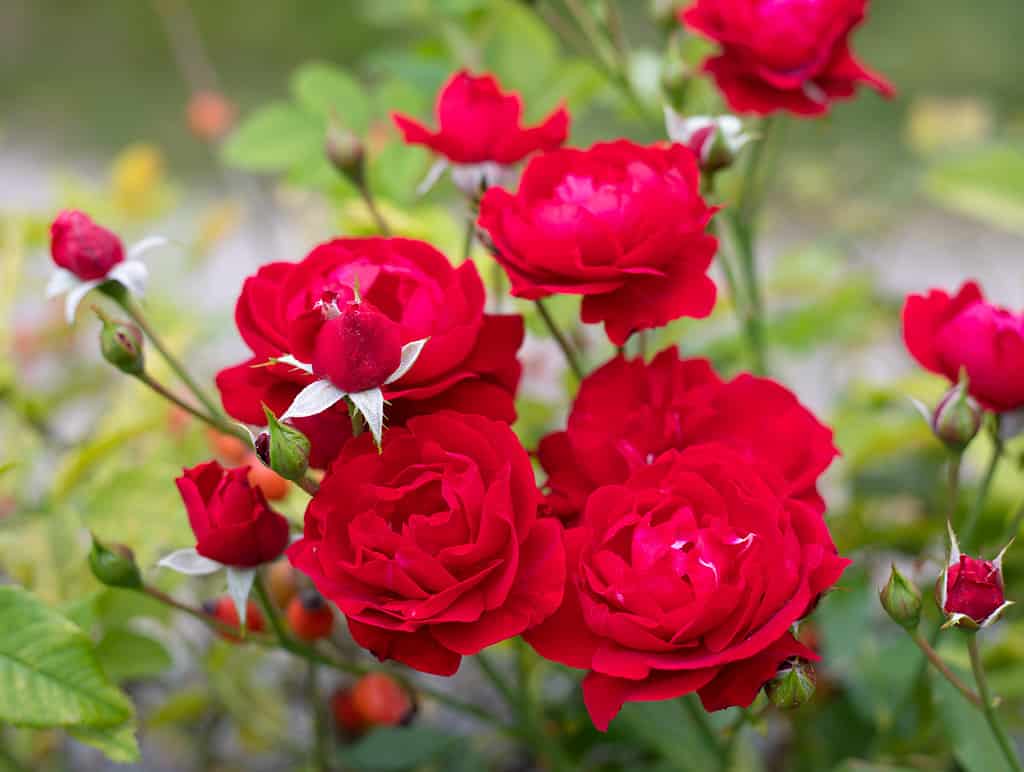
Deadheading roses prevents seed production and creates fresh blooms.
©Maria Rzeszotarska/iStock via Getty Images
When to Deadhead Roses
Deadhead roses as their flowers go over, look tatty or fade. Do it sooner rather than later so your rose’s energy goes into new bud production, not seed development.
You’ll usually need a major deadheading session when the first flush of flowers is nearing the end, but picking out individual spent blooms as they go over keeps the display fresh.
All About Deadheading Roses
Two methods for deadheading roses exist. Choose the correct one for what you’re trying to remove. You’ll likely employ the first stage before the second, but at some point, you’ll end up doing both.
So, do you need a single flower removed or a flower cluster?
Let’s make an example of multiflora shrub roses shrubs first.
Remove a Single Bloom
It’s a good idea to deadhead roses as soon as the petals begin to fall. Often, this means just one bloom from a multi-flowering head of healthy flowers and buds. You do not need to remove the whole head. Just the one flower that’s spoiling the view.
To remove a single bloom, use small secateurs or snips to clip off the individual bloom where it meets the stem. Pop the deadhead into your bucket and move on.
Remove a Flowering Head
Once all of the blooms on a flowering head are spent, you can snip off the whole stem. To find the right place, follow a spent stem down to the junction with its first five-leafleted leaf. Cut the stem just above the junction.
So, that’s the technique down! Here’s how to apply that knowledge to different rose species.
Deadheading Tea Roses
Tea roses bloom large individual heads rather than flower clusters. To deadhead a spent tea rose, snip off the flowerhead, plus around eight inches of stem, just above a leaf. This avoids a beheaded bare-stemmed display, which is never attractive. Before long, a new flowering shoot will emerge from the leaf junction.

Deadhead hybrid tea roses just above the junction with its first five-fingered leaf.
©Salicyna / CC BY-SA 4.0 – License
Deadheading a Climbing Rose
Deadheading climbing roses is a combination of the above. Snip off dead heads at their stem’s base and clusters or large individual blooms at a junction with the top leaf. New flower shoots will emerge from the junction.
Deadheading a Rambling Rose
Rambling roses are different from shrub or tea roses. They employ different growth tactics, so you need a different approach to keep them looking good.
The difference between a rambling rose and a climbing rose is twofold. First, a rambling rose is far more vigorous than a climber. Some ramblers grow over fifteen feet in one year. Secondly, a rambling rose will have just one flush of small flowers, chiefly in early spring. A climbing rose will bloom on and off all summer.
This means a rambling rose doesn’t really need much deadheading. Its flowers all bloom and die at the same time. However, you can’t rest on your laurels after a rambling rose has bloomed because it’s time to prune it!
Ramblers bloom on last year’s growth, so they quickly appear leggy, with no flower growth on the old wood. Cut back all flowering growth produced this year to obtain beautiful flowers next year. You can prune harshly because rambling roses are tough. Then, over the course of this year, your rambler will grow new stems, and they will flower next year.
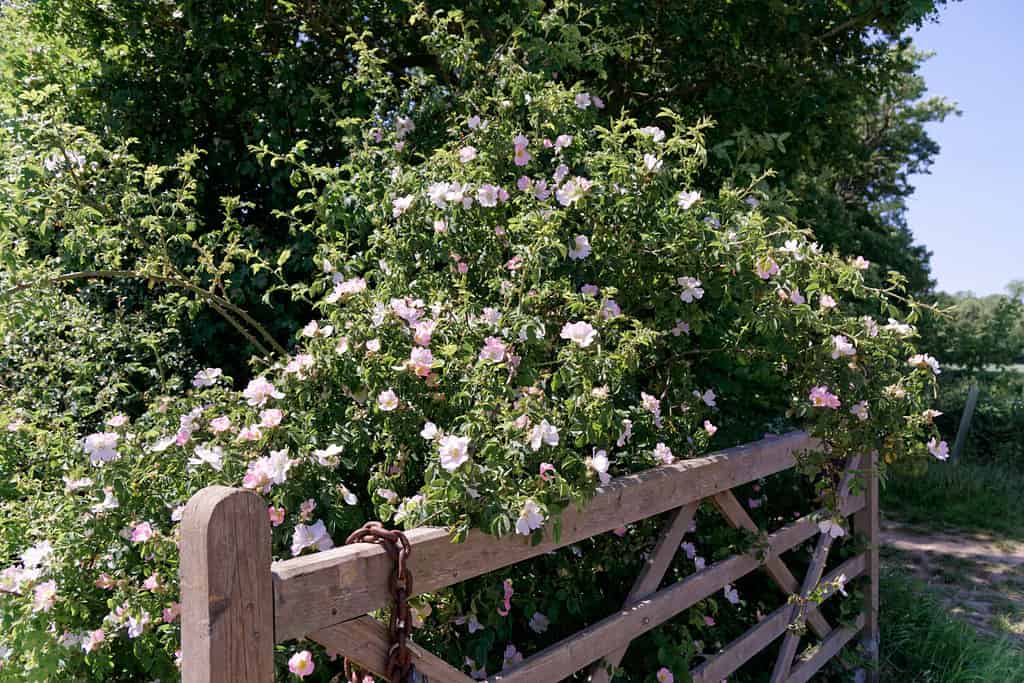
Prune rambling roses as soon as the flowers have finished blooming.
©CarlsPix/Shutterstock.com
Deadheading a Patio Rose
Compact patio roses follow the same pruning pattern as tea roses and shrub roses. Simply snip off individual dead flowers, and when the flower cluster is spent, remove the whole cluster at a leaf junction.
After Deadheading: Top Tips
After you’ve snipped away dead rose flowers, your rose bush will change gear and go into overdrive, producing new flowers.
This means it requires resources and needs your assistance to get them.
First off, trim down any extra-tall stems that tower above leaf joints to create an attractive, rounded shrub.
Then, give rose shrubs a long, deep drink of water. Fertilize them with quick-acting liquid rose to feed the following day, and apply a thick layer of mulch to the base. Keep a watchful eye out for pests, too. When ladybugs appear in the yard, transfer them to your rose bushes. Ladybugs might look pretty, but in reality, they’re voracious aphid predators.
One last job before you can put the kettle on! Thoroughly clean your snips or secateurs to prevent disease from spreading through the yard. Wiping away sap also keeps the blades in tip-top condition.
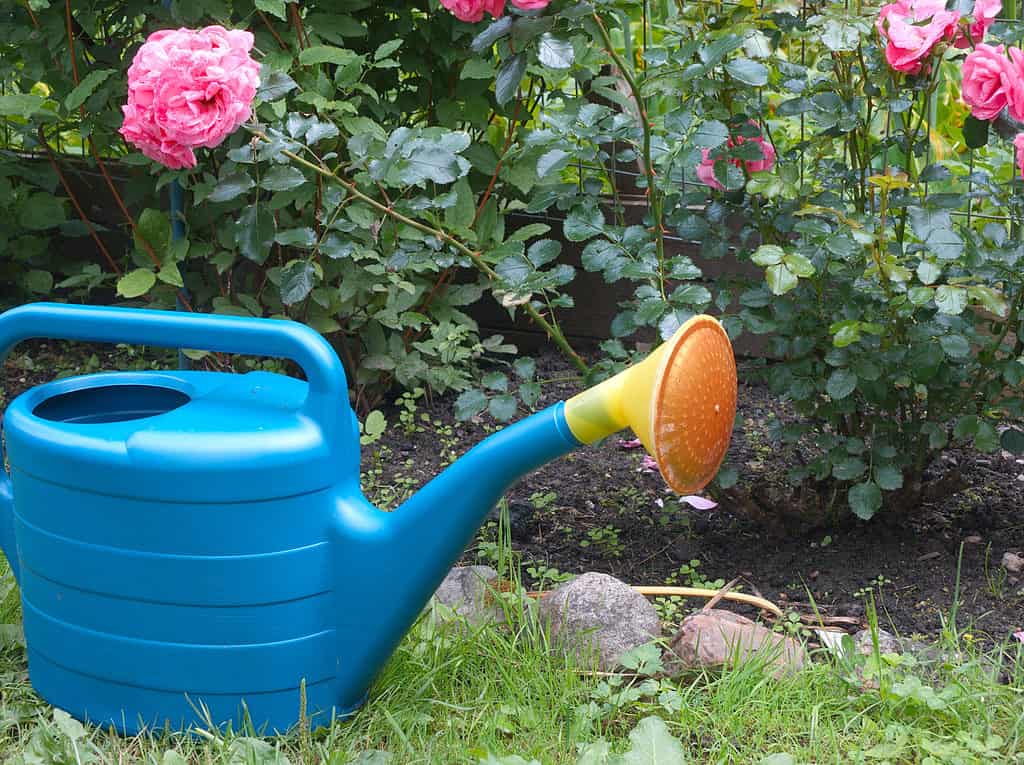
Water roses thoroughly after deadheading.
©iStock.com/victorass88
How to Grow Beautiful Roses
Beautiful rose displays require regular deadheading plus the following:
Water
Roses need regular water to produce flowers and healthy foliage. A parched rose is fodder for disease and pests. Water roses deeply at least once a week. Container roses may require water every day.
Sunlight
Roses thrive in sunshine, and there are very few cultivars that cope with shade. In general, roses need at least six hours of sun each day to produce blooms.
Fertilizer
Hungry roses blast through fertilizer! When buds appear, fertilize roses each week with liquid feed.
Mulch
Roses are shrub species that greatly benefit from mulch, and it’s difficult to grow them without it. A two-to-three-inch deep pile of mulch around the roots traps moisture, prevents weed growth, and, in the case of organic mulch, provides summer-long nutrients.
Shelter
A rose shrub in the rain and wind won’t produce many flowers. It’s best to grow roses in a sheltered, sunny spot. If yours are too exposed, wait until the fall to move them.
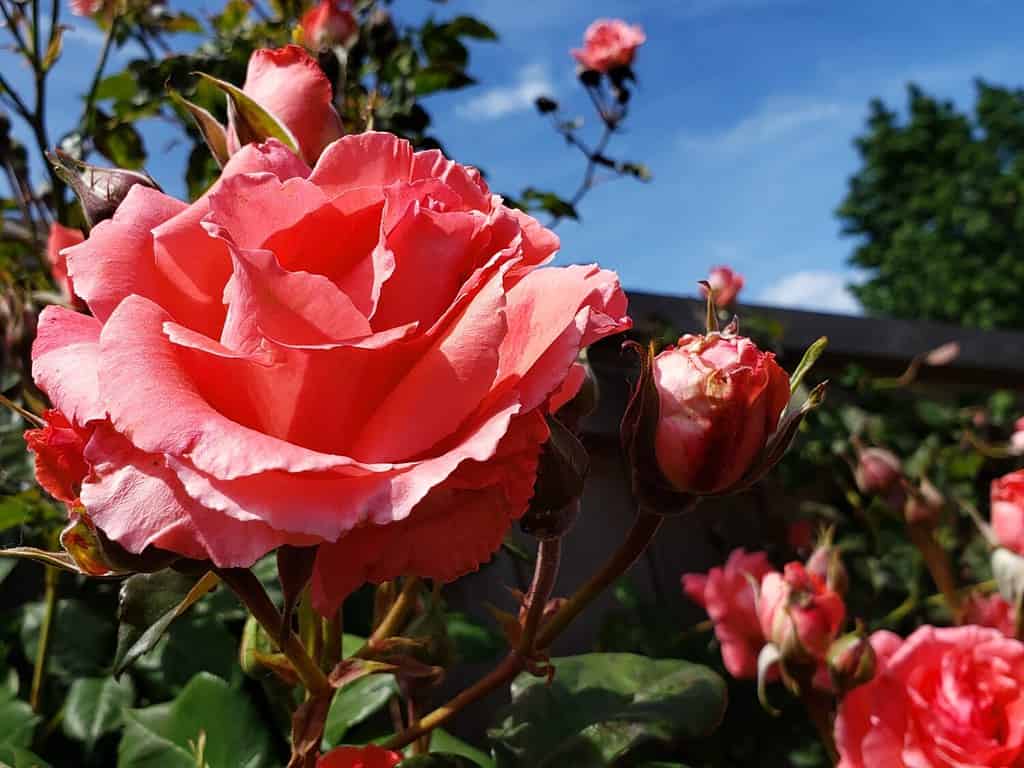
Roses need at least six hours of sun each day to thrive.
©Warren Payne/Shutterstock.com
Deadheading Roses: Why Bother?
Although roses happily grow without deadheading, the process creates a better-looking display of fresh flowers. Most rose lovers grow iconic roses for the flowers, and deadheading produces more. It also helps prevent rot, diseases, and unkempt roses that look unattractive.
It’s not difficult, but it can be time-consuming. It’s best to keep on top of deadheading with a few snips every other day.

Deadhead roses little and often for a summer-long bloom.
©iStock.com/morrowlight
The photo featured at the top of this post is © Alisa_Ch/Shutterstock.com
Thank you for reading! Have some feedback for us? Contact the AZ Animals editorial team.






